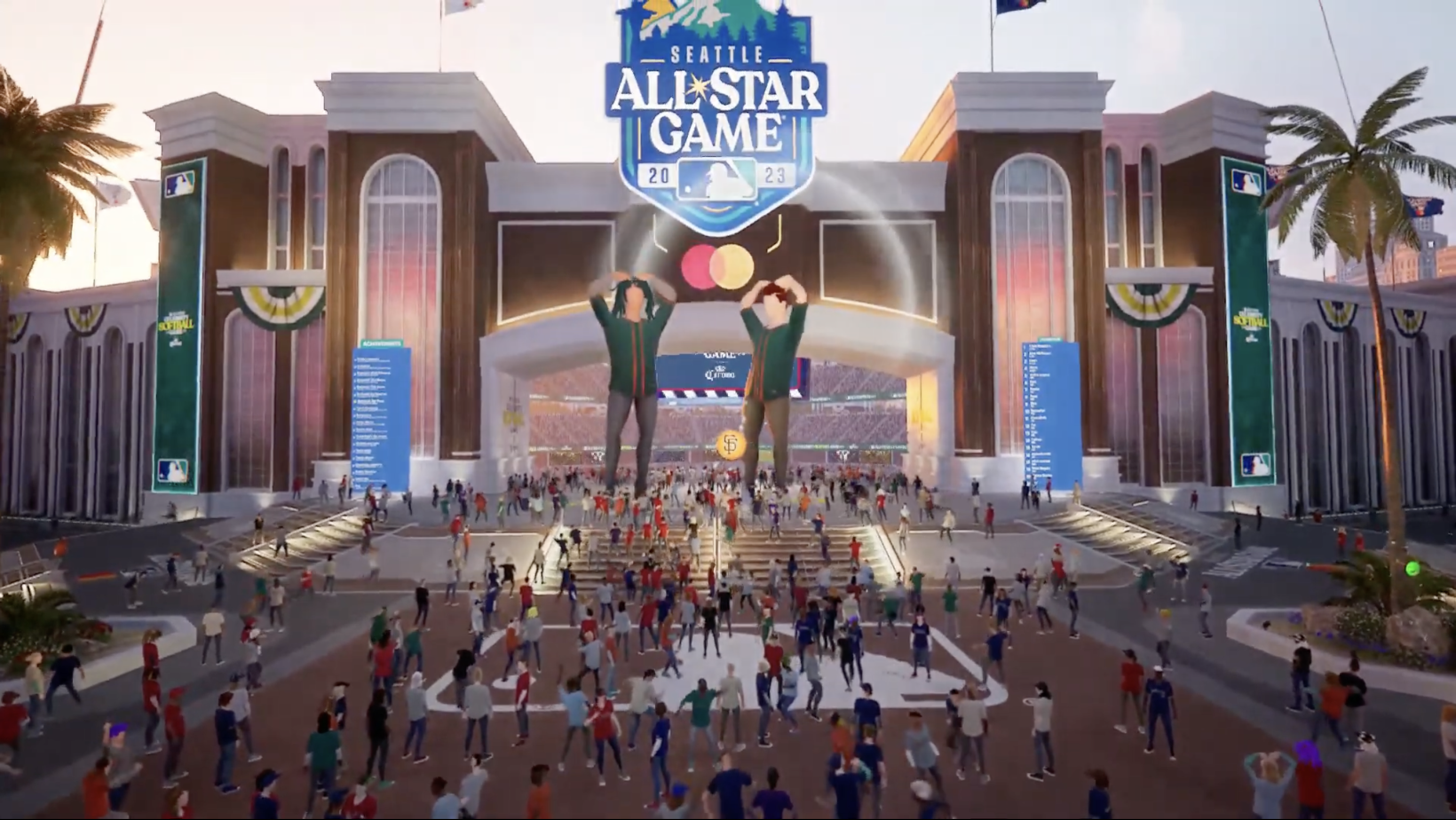
On a typical visit to a sports stadium, you don’t bump into 20-metre-tall giants outside the gates. But this isn’t your typical sports stadium. It’s the MLB virtual ballpark — the first metaverse for a pro sports league.
The venue opened on July 8, for a watch party during Major League Baseball’s All-Star Weekend. Hosting the event were the aforementioned giants, who begin the festivities with a tease:
“Who knows what prizes will be up for grabs? Make sure you explore and have fun.”
The incentives for engagement are accentuated. Sure, you could just chat with fellow fans and watch the game on the venue’s jumbotrons, which flick into full-screen mode on your device. But the giants really want you to collect points for prizes. They offer myriad ways of winning them: traversing the site, playing mini-games, doing quizzes, collecting baseball cards, or just staying till the final whistle.

As a purist, it can’t compare with the traditional matchday experience of pre-match beers, expletive-laden chants, and good old-fashioned hooliganism. But this isn’t a traditional matchday experience. The target audience is fans watching in homes around the world — and there are big opportunities to monetise them.
Surveys show that most TV viewers are also using second screens. Among Gen Z and Millenials, the percentage is as high as 95%. While watching sports, they’re also using social media, shopping, texting, and gaming. Gen Z is also twice as likely to pay for sports content than boomers are. But they’re far less likely to watch entire live events.
“We know that the older generations are still consuming the full event in a more traditional experience,” said Luis Vicente, chairman of Apex Capital, a sports and entertainment investment company. “For the younger audience, you need to be more innovative and keep delivering them content in new and fresh ways that fit with how they naturally want to consume their favourite sporting moments”
The MLB virtual ballpark promises to integrate these methods of consumption. But more proof is needed that it’s more than just a gimmick or a Second Life knock-off.
“Then the value propositions of what that space enables come to life.
A few days later, there’s a new attempt to convert the cynics. Another virtual world has opened for a very difficult sporting experience: a Q&A with Nwankwo Kanu, an iconic former footballer for English side Arsenal.
In this virtual world, the focus shifts from leagues and teams to athletes and communities. Over 1,100 attendees could interact with one another and Kanu. Adding a sprinkle of stardust to the session was Oleksandr Zinchenko, a stalwart of the current Arsenal team, who popped by to ask a question. There was also a more formal interview, hosted by Robbie Lyle, the founder of Arsenal fan platform AFTV.
“Football is all about opinions and these experiences allow for fans to come and converse about football,” said Lyle. “I see the metaverse becoming another platform like Twitter, TikTok, YouTube where fans can engage and have fun together.”
Both the ballpark and the Kanu Q&A were developed by Improbable, a London-based tech firm. Founded in 2012, the company’s massive simulations have attracted a $3bn (€2.7bn) valuation, but the path to profitability has been a rocky one. In 2021, the company recorded losses of £152mn.
The following January, Improbable unveiled a new strategy: a move away from games to double down on the metaverse.
Moving to a new world
After the announcement, Improbable sold its stakes in game studios Midwinter and Inflexion, as well as its defence and national security business. In their place was a new focus on critical infrastructure for virtual worlds — the plumbing of the metaverse.
The bedrock of the project is Improbable’s Morpheus technology. A descendant of the company’s earlier SpatialOS product, Morpheus provides a sense of presence and social interactions for over 10,000 people in dense virtual spaces.
Morpheus also powers the centrepiece of Improbable’s strategy: MSquared (M2) — a network of interoperable metaverses. Launched in June, the network combines technologies, services, and standards — as well as $150mn (€138mn) in funding — to provide and interlink digital experiences.
Among the early users is the MLB virtual ballpark, which can tap M2 to interconnect with other virtual worlds.
“Now that baseball fans can technically hang out with football fans on M2, you might find some very strange crossovers and connections,” Herman Narula, the CEO and co-founder of Improbable, tells TNW.

Despite growing scepticism about the metaverse, Narula, remains bullish about his ambition. He argues that clearer use cases are emerging.
“I think it’s a lot like the dot-com boom,” Narula tells TNW over Zoom. “We all remember the crash, but what happened after the crash was really amazing companies formed. Because the world had the right idea. Yes, online experiences were going to matter a lot. But it took time for the technology, the consumer awareness, and the experiences to catch up.”
Narula recalls a famous Bill Gates appearance on the Late Show with David Letterman. It was 1995, and Microsoft had just launched Internet Explorer — its first online tool. Patiently, Gates told his host about the internet’s potential.
Letterman was unimpressed. Derisively, he referenced a “breakthrough” about a baseball game being streamed online. “You could listen to a baseball game on your computer. And just thought to myself, does radio ring a bell?” he scoffed.
Undeterred, Gates explained that fans could watch the game whenever they wanted. ″Do tape recorders ring a bell?” Letterman quipped.
Narula thinks we’re at a similar moment for sports in the metaverse. Initially, he admits, most fans don’t recognise the possibilities.
“But then the value propositions of what that space enables come to life. You could meet football players, interact with them or see their interviews, but to have the entire crowd seen by them — that ended up being the killer feature. That completely changed everything. That changes everyone’s attitude, that changes everyone’s reactions, that provides more fulfilment.”
Sport enters the metaverse
Metaverse boosters have high hopes for sports. Analysts at investment firm Web3 Studios predict that the value of the sports metaverse could hit $80bn (€72.3bn) by 2030.
Naturally, such optimistic estimates will provoke cynicism — particularly when they serve a vested interest. But sports are notoriously undermonetised.
Take the football club Manchester United. The English side is estimated to have 1.1 billion fans — the most of any team in the world. In the financial year ending June 2022, the club recorded revenues of £583.2mn (€674.9mn), which means United effectively generated just €0.61 per fan that year.
Amazon, by contrast, has previously reported 200 million unique monthly visitors in the US alone. Across a year, they’re monetised at an annual revenue of over €902 per visitor.
“What keeps people on the platform is each other.
Gaming also gets more money from users. In 2020, Blizzard Entertainment, the maker of World of Warcraft, generated $62 in revenue per monthly active user. That money comes through sales of games and in-game spending — two avenues that sports can capitalise on.
Improbable is betting that the metaverse can close the gap for sports. The company envisions various new revenue streams for the sector, from virtual experiences and digital apparel to broadcast models and advertising services.
“In terms of economics, it’s really simple,” says Narula. “If the metaverse succeeds, it will vastly increase the value of sport.”

The metaverse is often described as an extension of gaming. Improbable, however, has pitched a very different business model. At its core is interoperable virtual worlds.
The plan dramatically expands an immensely popular feature of Fortnite and Roblox. Both gaming platforms — sometimes described as “proto-metaverses” — allow creators to build and monetise their own content. But the content remains economically locked to the platform.
Evidently, the proposition is still attracting interest from the sports sector. The NFL, for instance, has produced a Roblox experience, where fans can build stadiums, draft teams, and roleplay as franchise owners.
“Suddenly, my business has more value.
With over 66 million daily Roblox users, the project has obvious promotional appeal. The product, however, is trapped in Roblox — which limits its scope.
“You can’t really build a business on someone else’s business where they’re taking a ridiculous percentage. But more importantly, they control the relationship with the user,” says Narula.
The MLB ballpark, by contrast, is a white-label product. Users enter by clicking a link on the Major League Baseball website. There’s no M2 logo in the experience, but the network allows digital assets to move between virtual worlds, which opens up cross-platform opportunities. A Red Bull Salzburg sports kit, for instance, could be sold and worn in multiple arenas — and give you wings in all of them.
“You’re building a strong network effect, because what keeps people on the platform is each other,” says Narula. “It’s the cross-referencing of their content; it’s the fact that I can take my Kanu-signed shirt to a baseball match, that makes it more valuable.”

Network effects are integral to the sports metaverse. In current virtual worlds — such as Meta’s — assets can’t be used outside the platform, which inhibits the network effects. Improbable, however, applies a more decentralised strategy.
The company designed M2 as a utility, with profit captured by using the service. After a business creates an experience, it can spread the asset across the entire network.
“By being part of the network, I get users from baseball, I get users from football, and I get to sell items that can be more valuable in other places,” says Narula. “Suddenly, my business has more value.”
Another crucial concept is “intimacy at scale.” In essence, this transmits the atmosphere and interactions from physical events to online spaces. To make this feeling accessible, the technical requirements must be minimised.
Improbable takes a dual approach to the issue. One option provides access to the metaverse via an internet connection and a basic smartphone, laptop, or desktop. But if users don’t have fast broadband, an AI-powered bandwidth compressor can condense a virtual world into only the specific updates that they need to see.
According to Narula, the system can condense the requirements of some cases to under 1Mbps.
“It’s vitally important that we get away from the idea that the metaverse requires a $3,000 headset,” he says. ”I want to reach an Arsenal fan on 3G anywhere in the world.”
Get the TNW newsletter
Get the most important tech news in your inbox each week.




